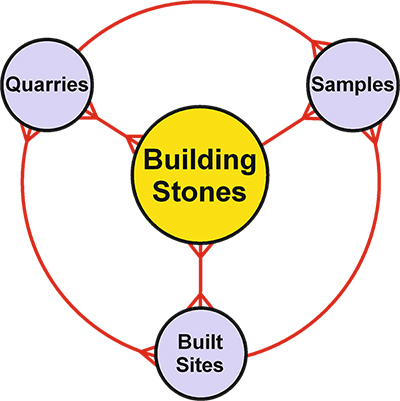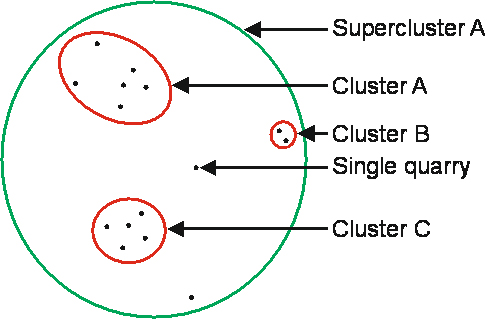Building Stone Database for Scotland


Welcome to the Building Stone Database for Scotland (BSDS). This ambitious project, which has been co-funded and developed by BGS and Historic Environment Scotland (HES), aims to define and describe all of the building stones of Scotland and provide details of associated quarries, built sites and samples for each one. The long-term objectives of the BSDS are to raise awareness and appreciation of the richness of the building stone legacy in Scotland, improve practices related to maintenance and conservation of built sites, and facilitate a re-invigoration of our indigenous building stone industry.

Information in the BSDS is organised in four themes: building stone (the 'core' theme), quarry, built site and sample (see Diagram 1). Each record is linked to associated records in other themes.
For example, the record for Locharbriggs Sandstone (a building stone) is linked to records for:
- all the quarries known to have produced this stone
- all the built sites known to contain the stone
- all known registered samples of the stone
A fundamental principle of the scheme is that any link made between a built site and a quarry or building stone must be supported by a written reference.
The database currently holds separate records for approximately 200 building stones, 3500 quarries, 800 built sites and 1000 samples. New records for all themes will be added periodically, but the main area of growth in future will be in the number of records for built sites.
The database can be accessed in two ways: using text in a search window or browsing thematic datasets in a map viewer.
Building stone
A building stone is a naturally occurring stone that has been used as a building material or in artefacts. The widely used term 'dimension stone' refers to building stone that is cut or otherwise worked to meet a specification relating to size or shape. Building stone may be used to form walling, dressings, cladding panels, foundations, roofing slate, paving, kerbstones and many other architectural or structural elements. The term encompasses stone used for monumental, decorative and sculptural purposes. It does not include crushed stone, aggregate, mortar, concrete or roadstone.
The building stones of Scotland have not previously been defined, so to create the BSDS each building stone is defined according to the geological unit from which it has been sourced; for example, the building stones Locharbriggs Sandstone and Aberdeen Granite are sourced from the geological units Locharbriggs Sandstone Formation and Aberdeen Granite Pluton, respectively. The BGS Digital Geological Map of Great Britain and the BGS Lexicon of Named Rock Units have been used as the main reference sources for this task. Defining building stones in this way means they are limited to a relatively small, manageable number and each is characterised by a set of distinctive, intrinsic geological properties (rock type, colour, texture and so on). Each building stone in this sense is a conceptual entity for which a general description can be provided based on samples in reference collections.
Quarries

A quarry is an excavation at the ground surface created by removal of building stone. Most of the information about quarries in the BSDS is sourced from the BGS Database of Mines and Quarries, or BritPits. Many of the quarries known to have produced building stone in Scotland occur in closely spaced clusters and these quarries commonly do not have unique names. This presents a significant challenge for the database, because in many cases the recorded information about a built site, sample or photograph only allows a link to be made with a quarry cluster rather than an individual quarry. In some parts of the country, the sheer number of quarries means that several quarry 'clusters' must be organised into one or more 'superclusters' (see Diagram 2). For this reason, records held in other themes of the BSDS may be linked to a quarry, a cluster or a supercluster, depending on how precise the recorded information is.
Some clusters are representative of the situation on the ground today, that is, two or more closely spaced quarries can be observed on the ground, whilst others reflect the historical development of quarrying at a site and may not be representative of the situation on the ground today. For example, several historical quarries may now have amalgamated, so there may be several records in the database but only one large quarry is visible today.
Built sites
A built site is a construction, area of construction, or artefact incorporating building stone.
Samples
A sample is a piece of stone that has been removed from a quarry or built site, assigned a unique id and stored in a reference collection. Each sample represents the visual and geological character of a building stone at a particular place and time. Currently, the BSDS only contains details of samples from quarries, but samples from built sites may be added in future.
Currently, all the samples included in the BSDS are held in the BGS Collection of UK Building Stones. Any of these samples (and their associated thin sections) can be examined directly by visiting the BGS office in Edinburgh — contact our enquiries team (enquiries@bgs.ac.uk) to ask about visiting. Photographs of many of the hand samples can be viewed through the BSDS.
In future, we hope to include details of samples held in other collections in the BSDS.




Follow us

